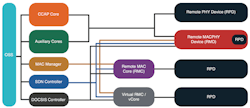On Sep. 30, CableLabs announced the release of its Flexible MAC Architecture (FMA) library of specifications. Along with the FMA System specification, CableLabs also released the FMA MAC Manager Interface (MMI) and the FMA PacketCable Aggregator Interface (PAI) specifications.
As laid out by a CableLabs statement:
"Over the past 20+ years, the cable industry has worked on access network aggregation. The DCA (Distributed CCAP Architecture) program, which began with Remote PHY, is being finalized to complete the disaggregation of the DOCSIS network. The FMA and DCA platforms are fundamental network designs to support 10G initiatives.
With bandwidth consumption skyrocketing, the need for increased network capacity, improved network performance, and efficient deployment of new services is at an all-time high and FMA supports each of these needs. With over a billion DOCSIS CMs and roughly 30,000 CCAPs deployed globally, the DCA program will allow the DOCSIS technology to support next-generation gigabit services, low latency applications and virtualization."
CableLabs says its issuance of the specifications "is the initial step in a comprehensive process in order for CableLabs vendor partners to develop products and ultimately for operators to deploy those products and provide 10G services."
In a blog for the company describing the new FMA specs, CableLabs lead architect for wired technologies, Jon Schnoor, explained:
"The FMA project is a part of the larger Distributed Access Architecture program at CableLabs. This program includes Remote PHY (R-PHY) as well as other projects like DOCSIS 4.0, Coherent Optics and others. FMA defines the standardization of the complete disaggregation of the CCAP management, control and data planes. The specification provides standard interfaces between OSS/NMS/Orchestration and the FMA management and control planes as well as a standard interface abstraction layer to cable access equipment. All of this allows for vendor independence and equipment interoperability.
As a part of the suite of technologies that support the 10G platform, FMA is a key disaggregated access network architecture that supports DOCSIS 4.0 requirements to achieve downstream speeds up to 10 Gbps and upstream speeds up to 6 Gbps. The FMA technology is complementary to the R-PHY technology and together complete a toolset of disaggregated technologies to support an operator’s next-generation data services."
The releases represent the "culmination of thousands of hours of work across the cable industry, on a global scale," said a CableLabs statment.
